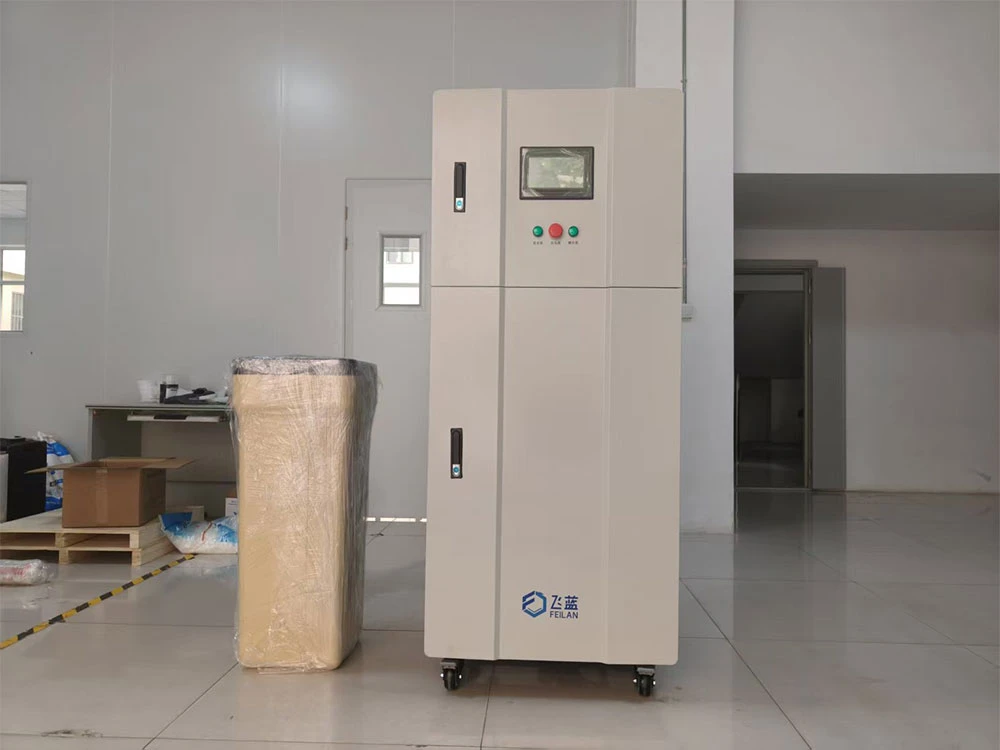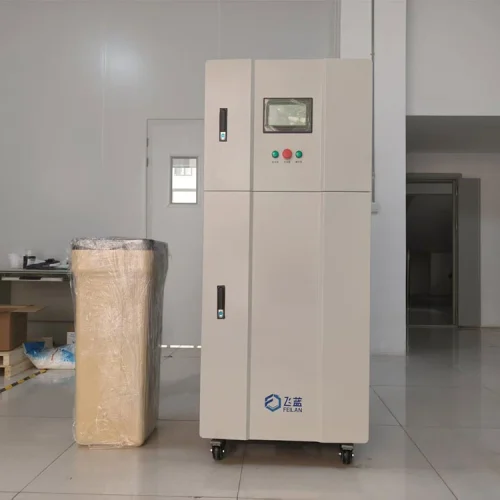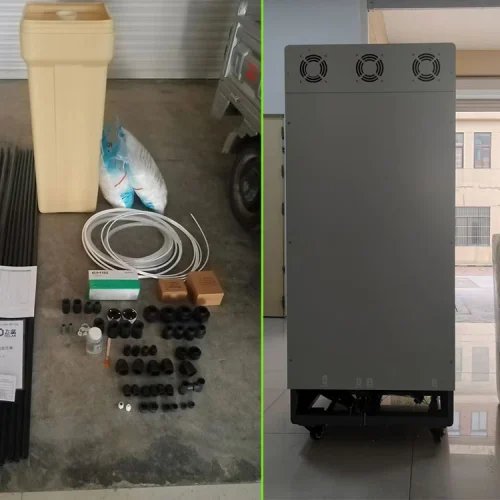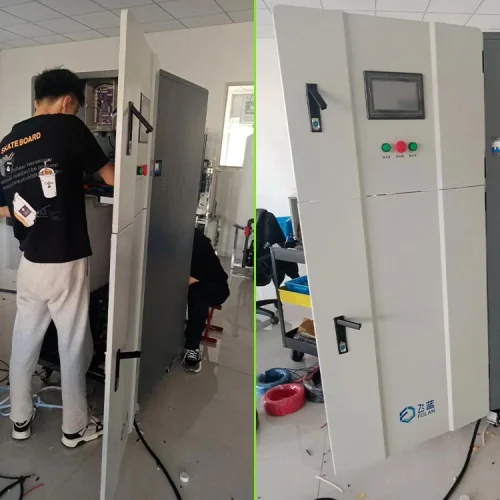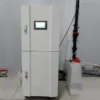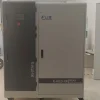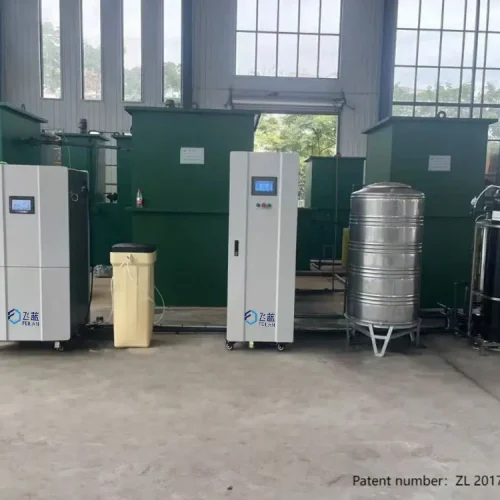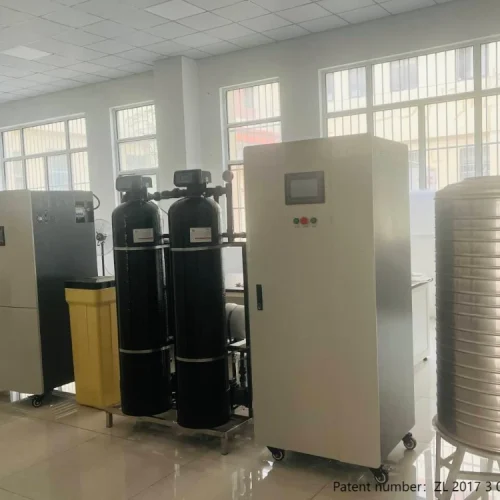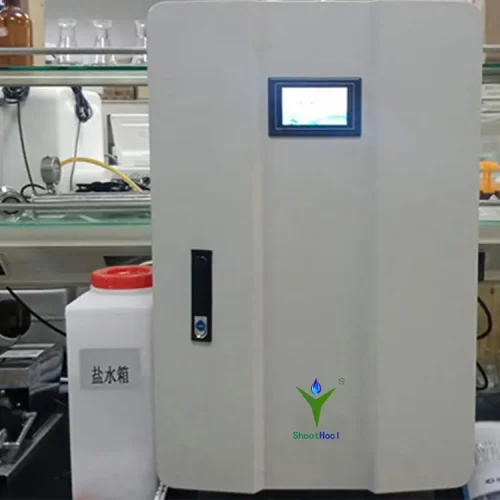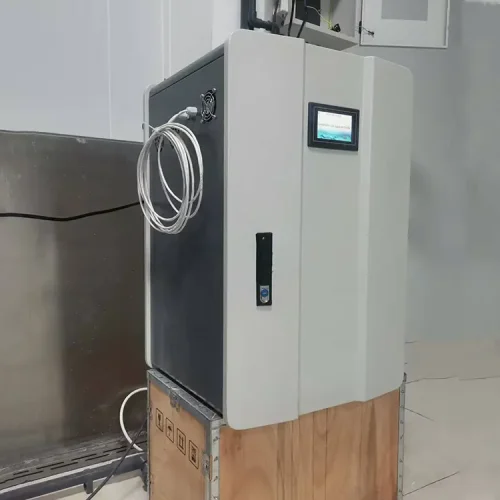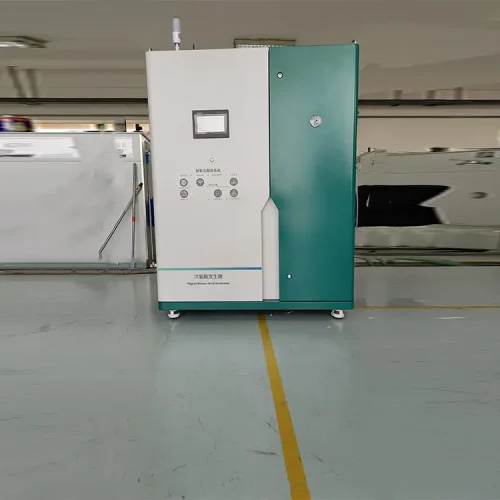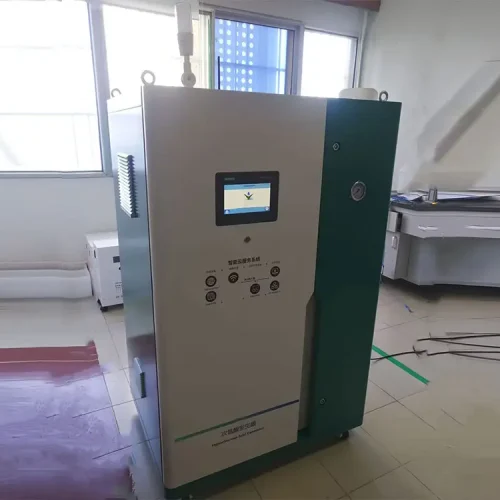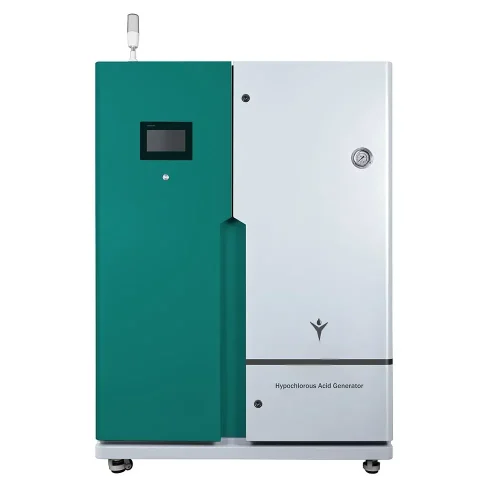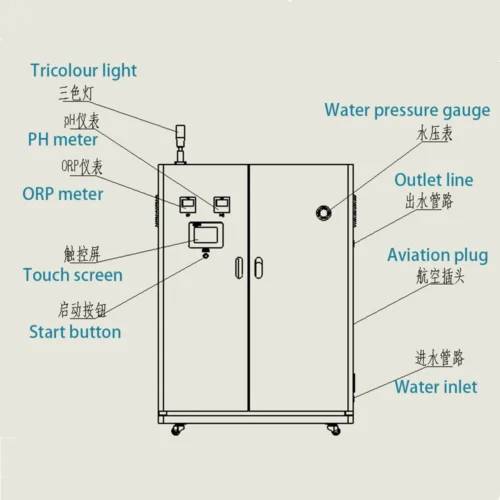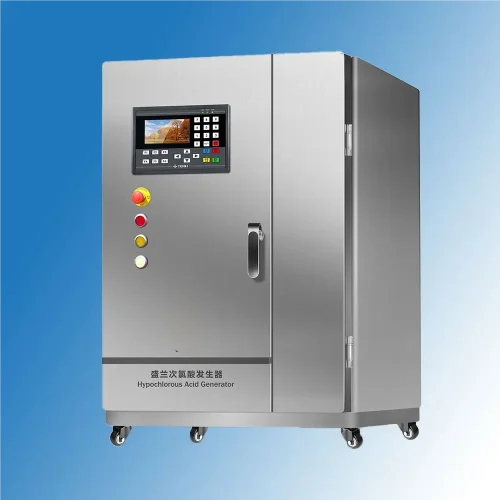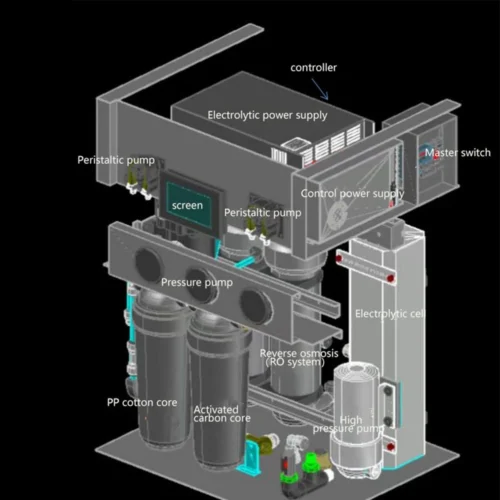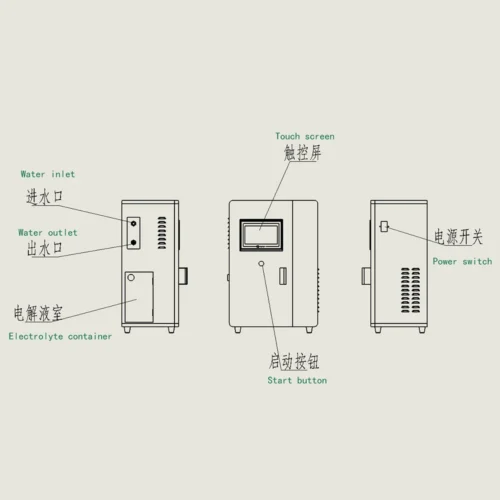The preservation of fruits and vegetables is of vital importance. Hypochlorous acid, as a new type of preservation technology, leaves no residue and is non-toxic, ensuring the quality and freshness of fruits and vegetables. It fully meets the current consumers’ pursuit of healthy and green food.
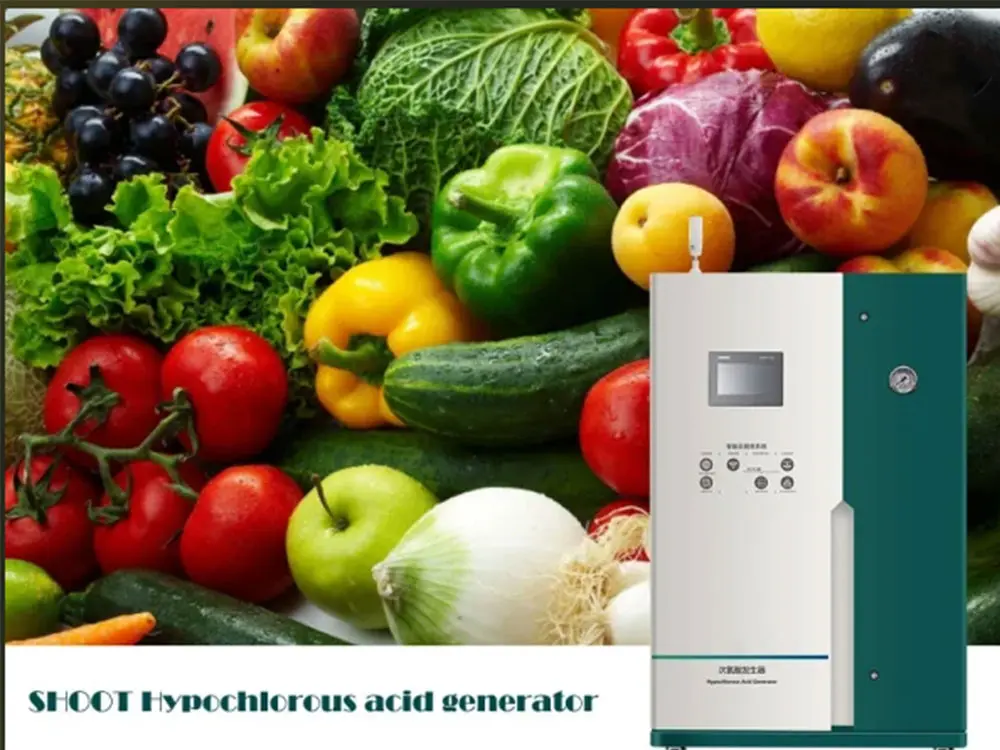
Parameters of hypochlorous acid generator
| Product name | Hypochlorous acid generators are used for the preservation of fruits and vegetables and to extend their shelf life |
|---|---|
| Concentration | 10-1000PPM(Adjustable) |
| Flow rate | 1000L/H |
| PH | 5.0-6.5 |
| Electrolyte | salt (Nacl) or hydrochloric acid (5% HCL) |
| Power | 6200W |
| Voltage | 380V/50Hz |
| Size | 70*60*175cm |
The principle of hypochlorous acid preservation
1. 1 Inhibits ethylene production and delays the ripening of fruits and vegetables
Ethylene is a plant hormone that plays a crucial regulatory role in the ripening and aging of fruits and vegetables. When fruits and vegetables start to ripen, they produce ethylene themselves. As the concentration of ethylene increases, the ripening and aging process of fruits and vegetables will accelerate. Hypochlorous acid can effectively inhibit the production of ethylene in fruits and vegetables, slowing down the ripening speed of fruits and vegetables from the root.
For example, in the research on the preservation of peaches, it was found that the ethylene release of peaches treated with hypochlorous acid was significantly reduced.
The hardness of the fruit is well maintained, which delays the time for the fruit to soften and rot, thereby extending the insurance period
1. 2. Powerful sterilization ability, reducing microbial invasion
The growth of microorganisms is one of the important factors leading to the spoilage and deterioration of fruits and vegetables.
During the processes of picking, transportation and storage, fruits and vegetables are very likely to be contaminated by bacteria,
fungi and viruses and other microorganisms. Hypochlorous acid has a powerful bactericidal ability,
and its bactericidal principle is based on the oxidizing property of hypochlorous acid. Hypochlorous acid can penetrate the cell walls of
microorganisms and undergo oxidation reactions with biological macromolecules such as enzymes, proteins and nucleic acids within the cells,
destroying the structure and function of microorganisms and thus killing them. Studies have shown that hypochlorous acid at a concentration of 50-150PPM
has a highly efficient killing effect on common pathogenic microorganisms in fruits and vegetables such as Bacillus cereus,
Salmonella, and Staphylococcus aureus, with a sterilization rate as high as 99.99%, significantly reducing the risk of fruits and
vegetables rotting and deteriorating due to microbial infection
1.3 Regulate respiratory metabolism and reduce nutrient consumption
After fruits and vegetables are picked, they remain living organisms and perform respiration. Respiration consumes oxygen, produces carbon dioxide and water, and releases energy. Excessive respiration can accelerate the aging of fruits and vegetables and the consumption of nutrients. Hypochlorous acid can regulate the postharvest respiratory metabolism of fruits and vegetables and reduce their respiratory intensity. Through appropriate processing, hypochlorous acid can maintain the respiration of
fruits and vegetables at a relatively stable level, reduce the consumption of nutrients such as vitamins and sugar, and thereby preserve the taste and
nutritional value of fruits and vegetables. For instance, in the preservation experiment of fresh-cut lettuce,
the use of hypochlorous acid combined with modified atmosphere packaging (5% oxygen and 10% carbon dioxide) not only effectively inhibits the respiration intensity of the lettuce but also maintains its good sensory quality, thereby extending its shelf life.

The significant advantages of hypochlorous acid generators in the preservation of fruits and vegetables
2,1 Spectral sterilization, fully ensuring the safety of fruits and vegetables
Compared with traditional preservation methods, hypochlorous acid produced by hypochlorous acid generators has the characteristic of broad-spectrum sterilization.
Traditional preservatives may only be effective against some microorganisms, while hypochlorous acid can effectively kill a variety of
pathogenic microorganisms including bacteria, fungi and viruses. Whether it is the common mold that causes fruits and vegetables to
rot or the pathogenic bacteria that cause foodborne diseases, hypochlorous acid can exert a powerful bactericidal effect,
providing comprehensive protection for fruits and vegetables, reducing the risk of bacterial contamination during the preservation process,
and ensuring the quality and safety of fruits and vegetables.
2, 2-hypochlorous acid is safe and residue-free
Food safety is one of the issues that consumers are most concerned about. After completing the task of sterilization and preservation, hypochlorous acid will rapidly decompose and revert to water and a small amount of salt, leaving no harmful substances on the surface of fruits and vegetables. This forms a sharp contrast with traditional chemical preservatives. Traditional chemical preservatives, such as certain chlorine-containing disinfectants, may lead to excessive chlorine residues if used improperly, posing a potential threat to human health. The hypochlorous acid produced by the hypochlorous acid generator complies with food safety standards from production to use,
allowing consumers to consume fruits and vegetables that have been preserved with hypochlorous acid with confidence.
2, 3-hypochlorous acid is highly efficient and rapid, immediately exerting a preservative effect
Hypochlorous acid has a rapid bactericidal effect and can take effect within a short period of time.
When fruits and vegetables are soaked or sprayed with hypochlorous acid solution produced by a hypochlorous acid generator,
hypochlorous acid can quickly come into contact with the microorganisms on the surface of the fruits and vegetables and kill them,
providing timely protection for them. Compared with some traditional preservation methods that take a longer time to
achieve preservation effects, the highly efficient and rapid characteristics of hypochlorous acid greatly improve the preservation efficiency,
especially suitable for large-scale preservation treatment of fruits and vegetables.

Application scenarios of hypochlorous acid generator in fruit and vegetable preservation
3.1 Pretreatment stage of fruits and vegetables after picking
After the fruits and vegetables are picked, timely pretreatment is the key first step for preservation.
The picked fruits and vegetables are directly immersed in the hypochlorous acid solution prepared by
the hypochlorous acid generator for soaking and cleaning. Generally, the soaking time is 2 to 10 minutes.
This not only removes the soil, dust and residual pesticides on the surface of fruits and vegetables,
but also effectively kills the microorganisms on the surface and reduces the initial bacterial count. For instance,
for berry fruits such as strawberries, soaking them in hypochlorous acid solution immediately after picking can significantly reduce the number
of mold on the fruit surface, lower the rot rate, and maintain the color and taste of the fruit. For leafy vegetables such as lettuce and spinach,
soaking and washing in hypochlorous acid solution can remove bacteria and insect eggs on the surface of the leaves,
thereby extending the freshness period of the vegetables
3. 2 Preservation during the processing of fruits and vegetables
The application of hypochlorous acid generators is particularly important in processes such as fresh-cut vegetable processing
and fresh-cut fruit and vegetable processing. After processes such as cutting and correction, the tissue structure of fruits and vegetables is damage,
making them more prone to microbial growth. At this point, using hypochlorous acid solution to spray or soak the processed fruits and vegetables for
disinfection can effectively kill newly grown microorganisms, ensuring the quality and safety of the products. Meanwhile,
hypochlorous acid can also inhibit the enzymatic Browning reaction of fruits and vegetables during processing, maintaining their color.
For instance, in the processing of fresh-cut apples, soaking the cut apple slices in hypochlorous acid solution for
a short while and then packaging them can effectively delay the discoloration of the apple slices and extend their shelf life.
3,3 Preservation in cold chain transportation
Cold chain transportation is an important link to ensure the freshness of fruits and vegetables, but even in a low-temperature environment,
microorganisms may still grow and reproduce slowly. Hypochlorous acid generators can produce hypochlorous acid on-site during
cold chain transportation and regularly spray or fumigate the transported fruits and vegetables.
The hypochlorous acid generator using salt as raw material has easily accessible production raw materials, low cost,
and the produced hypochlorous acid does not leave any hazardous chemicals, making it safer. For instance, in refrigerated trucks used for long-distance transportation,
installing small hypochlorous acid generators and regularly spraying hypochlorous acid mist into the cargo compartment can continuously inhibit the growth
of microorganisms on the surface of fruits and vegetables, reduce spoilage and deterioration caused by microorganisms,
and ensure the quality of fruits and vegetables during transportation.
3. 4 Preservation in supermarkets and retail terminals
In retail terminals such as supermarkets and farmers’ markets, fruits and vegetables are display for a long time and are prone to
microbial contamination in the environment. Regularly spraying or wiping fruits and vegetables with hypochlorous acid solution prepared by
a hypochlorous acid generator can maintain their freshness and reduce losses. Meanwhile, hypochlorous acid has no pungent smell and
will not affect the shopping environment of supermarkets. For instance, on the fruit shelves in supermarkets,
staff can regularly spray hypochlorous acid solution on the fruits to keep them fresh, maintaining their bright color and good taste,
which attracts consumers to purchase them.
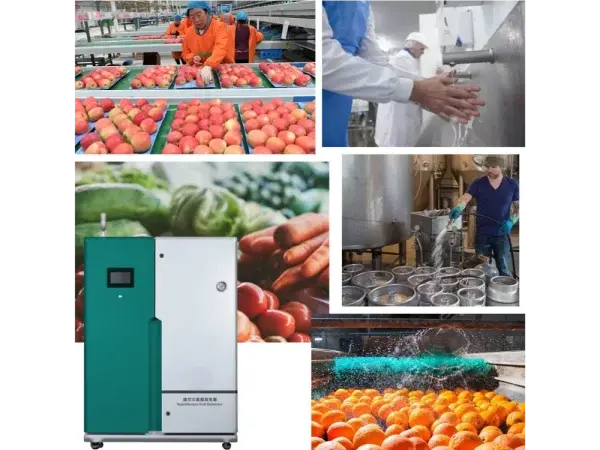
Factory strength
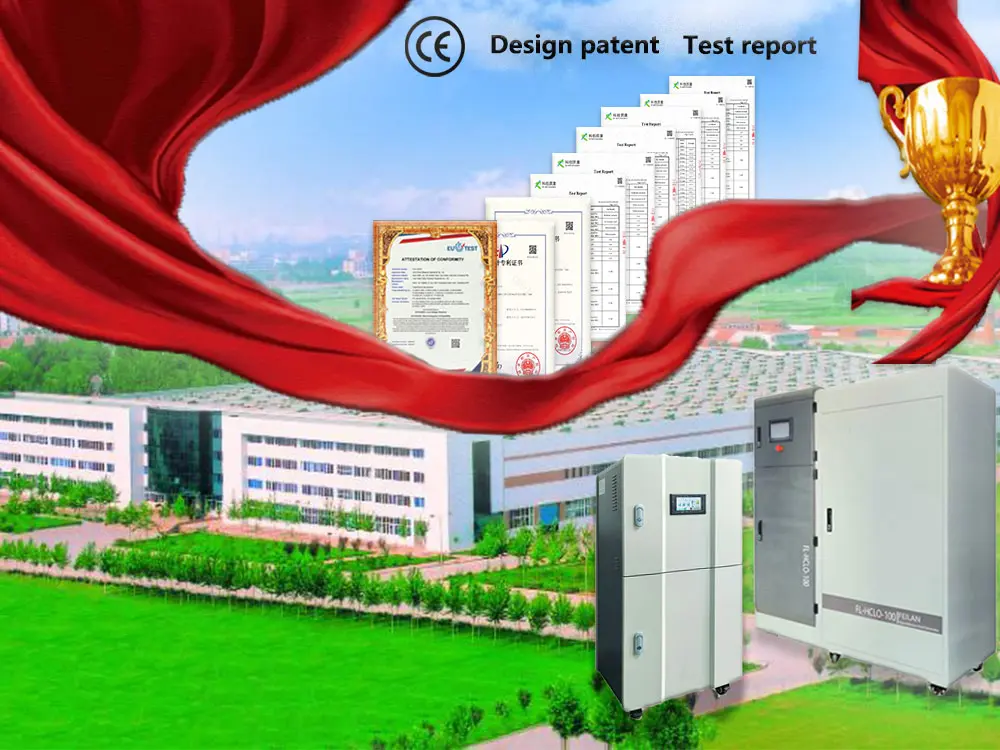
Customer feedback

Shipping capacity


